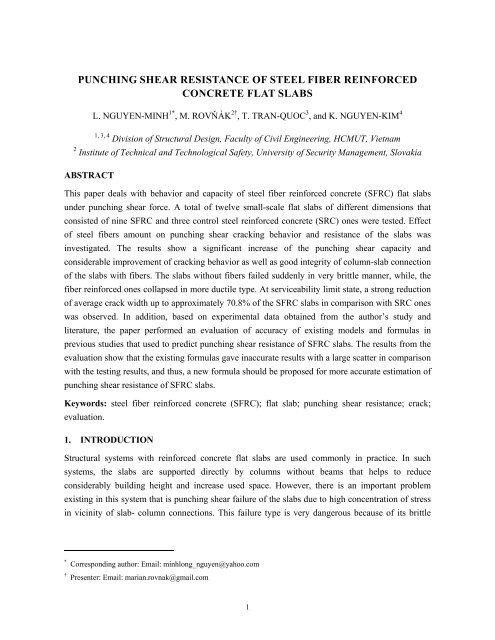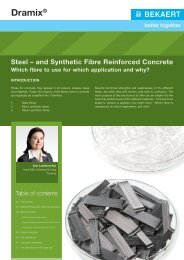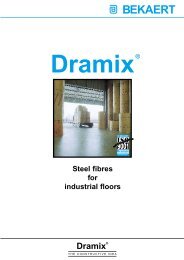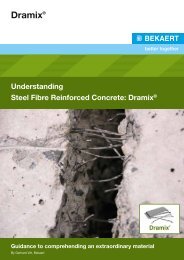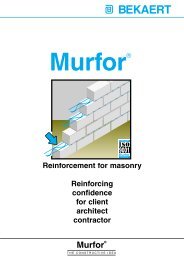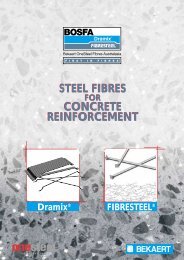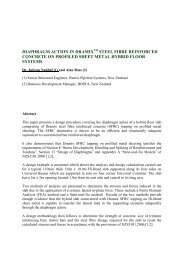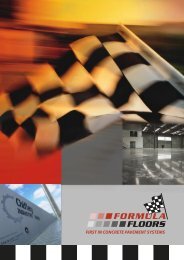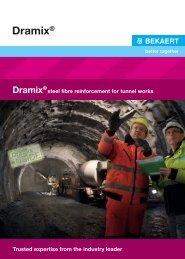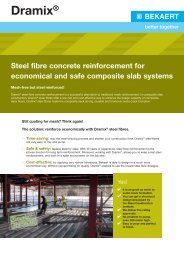punching shear resistance of steel fiber reinforced concrete ... - BOSFA
punching shear resistance of steel fiber reinforced concrete ... - BOSFA
punching shear resistance of steel fiber reinforced concrete ... - BOSFA
Create successful ePaper yourself
Turn your PDF publications into a flip-book with our unique Google optimized e-Paper software.
PUNCHING SHEAR RESISTANCE OF STEEL FIBER REINFORCED<br />
CONCRETE FLAT SLABS<br />
L. NGUYEN-MINH 1* , M. ROVŇÁK 2† , T. TRAN-QUOC 3 , and K. NGUYEN-KIM 4<br />
1, 3, 4 Division <strong>of</strong> Structural Design, Faculty <strong>of</strong> Civil Engineering, HCMUT, Vietnam<br />
2 Institute <strong>of</strong> Technical and Technological Safety, University <strong>of</strong> Security Management, Slovakia<br />
ABSTRACT<br />
This paper deals with behavior and capacity <strong>of</strong> <strong>steel</strong> <strong>fiber</strong> <strong>reinforced</strong> <strong>concrete</strong> (SFRC) flat slabs<br />
under <strong>punching</strong> <strong>shear</strong> force. A total <strong>of</strong> twelve small-scale flat slabs <strong>of</strong> different dimensions that<br />
consisted <strong>of</strong> nine SFRC and three control <strong>steel</strong> <strong>reinforced</strong> <strong>concrete</strong> (SRC) ones were tested. Effect<br />
<strong>of</strong> <strong>steel</strong> <strong>fiber</strong>s amount on <strong>punching</strong> <strong>shear</strong> cracking behavior and <strong>resistance</strong> <strong>of</strong> the slabs was<br />
investigated. The results show a significant increase <strong>of</strong> the <strong>punching</strong> <strong>shear</strong> capacity and<br />
considerable improvement <strong>of</strong> cracking behavior as well as good integrity <strong>of</strong> column-slab connection<br />
<strong>of</strong> the slabs with <strong>fiber</strong>s. The slabs without <strong>fiber</strong>s failed suddenly in very brittle manner, while, the<br />
<strong>fiber</strong> <strong>reinforced</strong> ones collapsed in more ductile type. At serviceability limit state, a strong reduction<br />
<strong>of</strong> average crack width up to approximately 70.8% <strong>of</strong> the SFRC slabs in comparison with SRC ones<br />
was observed. In addition, based on experimental data obtained from the author’s study and<br />
literature, the paper performed an evaluation <strong>of</strong> accuracy <strong>of</strong> existing models and formulas in<br />
previous studies that used to predict <strong>punching</strong> <strong>shear</strong> <strong>resistance</strong> <strong>of</strong> SFRC slabs. The results from the<br />
evaluation show that the existing formulas gave inaccurate results with a large scatter in comparison<br />
with the testing results, and thus, a new formula should be proposed for more accurate estimation <strong>of</strong><br />
<strong>punching</strong> <strong>shear</strong> <strong>resistance</strong> <strong>of</strong> SFRC slabs.<br />
Keywords: <strong>steel</strong> <strong>fiber</strong> <strong>reinforced</strong> <strong>concrete</strong> (SFRC); flat slab; <strong>punching</strong> <strong>shear</strong> <strong>resistance</strong>; crack;<br />
evaluation.<br />
1. INTRODUCTION<br />
Structural systems with <strong>reinforced</strong> <strong>concrete</strong> flat slabs are used commonly in practice. In such<br />
systems, the slabs are supported directly by columns without beams that helps to reduce<br />
considerably building height and increase used space. However, there is an important problem<br />
existing in this system that is <strong>punching</strong> <strong>shear</strong> failure <strong>of</strong> the slabs due to high concentration <strong>of</strong> stress<br />
in vicinity <strong>of</strong> slab- column connections. This failure type is very dangerous because <strong>of</strong> its brittle<br />
* Corresponding author: Email: minhlong_nguyen@yahoo.com<br />
† Presenter: Email: marian.rovnak@gmail.com<br />
1
nature. Once, the <strong>punching</strong> <strong>shear</strong> failure occurs, <strong>resistance</strong> <strong>of</strong> the structure is significantly reduced,<br />
which causes separation <strong>of</strong> the column and slab, and then lead to collapse <strong>of</strong> the whole structure.<br />
To increase <strong>punching</strong> <strong>shear</strong> capacity <strong>of</strong> flat slab, a variety <strong>of</strong> methods have been proposed such as: i)<br />
traditional <strong>shear</strong> reinforcing method using stirrups but this method is inapplicable to slabs with<br />
shallow depth less than 150 mm (ACI 318-2002); 2i) new method using headed-studs but this one<br />
need much time for construction (Feretzakis 2005). Recently, new technique using <strong>steel</strong> <strong>fiber</strong>s to<br />
improve the <strong>punching</strong> <strong>shear</strong> <strong>resistance</strong> and cracking control <strong>of</strong> slab-column connections has been<br />
proven to give good results (Alexander and Simmonds 1992; Theodorakopoulos and Swamy 1993;<br />
Harajli et al. 1995; McHarg et al. 2000, Naaman et al. 2007; Cheng and Montesinos 2010a).<br />
Moreover, <strong>steel</strong> <strong>fiber</strong>s also indicate high effectiveness in structures sustained lateral loads i.e.<br />
seismic because <strong>of</strong> their ability to absorb energy dissipation <strong>of</strong> the structures (Megally and Ghali<br />
2000; Cheng and Montesinos 2010b). Nevertheless, so far, it can be seen that researches related to<br />
this new method are only a few. This fact causes knowledge <strong>of</strong> behavior and <strong>punching</strong> <strong>shear</strong><br />
capacity <strong>of</strong> SFRC flat slabs to be still limited.<br />
Currently, several formulas exist which were proposed for estimation <strong>of</strong> <strong>punching</strong> <strong>shear</strong> capacity <strong>of</strong><br />
SFRC slabs (Shaaban and Gesund 1994; Harajli et al. 1995; Choi et al. 2007). Formulas <strong>of</strong> Shaaban<br />
and Gesund and <strong>of</strong> Harajli were pure-empirical based on <strong>punching</strong> model <strong>of</strong> ACI 318. These<br />
formulas are simply and easy to use, but due to their experimental nature, the formulas can not<br />
determine mechanisms <strong>of</strong> <strong>punching</strong> <strong>shear</strong> transfer quantitatively that can lead to inaccurate results<br />
in comparison with tests results. Whereas, Choi’s formula was derived semi-analytically by using a<br />
strength model which directly links failure criterion <strong>of</strong> FRC to <strong>punching</strong> <strong>shear</strong> capacity <strong>of</strong> slabcolumn<br />
connections. The formula was established based on assumption that yielding <strong>of</strong> tensile<br />
reinforcement occurs prior to <strong>punching</strong> <strong>shear</strong> failure. However, this assumption can be valid only in<br />
case <strong>of</strong> thin slabs (large span to thickness ratio) where behavior <strong>of</strong> slabs is dominated by flexural<br />
deformation. Moreover, effect <strong>of</strong> dowel action <strong>of</strong> tensile re-bars on the <strong>punching</strong> <strong>shear</strong> <strong>resistance</strong> <strong>of</strong><br />
slabs is ignored in all <strong>of</strong> formulas that could decrease their accuracy in case <strong>of</strong> slabs with higher<br />
reinforcement ratios.<br />
The paper presents an experimental study <strong>of</strong> effect <strong>of</strong> <strong>steel</strong> <strong>fiber</strong>s on the <strong>punching</strong> <strong>shear</strong> <strong>resistance</strong><br />
and cracking behavior <strong>of</strong> SFRC slabs, in which, a total <strong>of</strong> twelve small-scale flat slabs <strong>of</strong> different<br />
dimensions was tested. Moreover, the paper provides evaluation <strong>of</strong> accuracy <strong>of</strong> existing formulas<br />
used to predict the <strong>punching</strong> <strong>shear</strong> capacity <strong>of</strong> SFCR flat slabs based on data <strong>of</strong> the authors and<br />
other researchers.<br />
2. EXPERIMENTAL PROGRAM<br />
2.1. Materials and test specimens<br />
Testing slabs were made from <strong>concrete</strong> which contained Portland cement, natural sand, coarse<br />
aggregate, and plasticiment (Table 1). Dramix hooked <strong>steel</strong> <strong>fiber</strong>s RC-80/60-BN were used in the<br />
2
test program. The length and diameter <strong>of</strong> individual <strong>fiber</strong>s were 60 mm and 0.75 mm. The tensile<br />
strength and elastic modulus <strong>of</strong> <strong>fiber</strong>s were 1100 MPa and 200 GPa. Cube specimens (150 mm)<br />
were used to determine the compressive f c,cube and splitting tensile strengths f sp,cube <strong>of</strong> <strong>concrete</strong>. The<br />
average <strong>concrete</strong> strengths f c,cube and f sp,cube were summarized in Table 2. Steel re-bars <strong>of</strong> 10 mm<br />
diameter were used as tensile reinforcement for slabs. The mechanical properties <strong>of</strong> re-bars were<br />
determined by tensile tests. The average yield stress f y and ultimate tensile strength f u <strong>of</strong> the re-bars<br />
were 492 MPa and 667 MPa. Their modulus <strong>of</strong> elasticity E s was 210 GPa.<br />
Table 1: Concrete mix proportions<br />
Materials Quantity per 1 m 3<br />
Cement Holcim PC40<br />
453 (kg)<br />
Sand, 0-4 mm<br />
624 (kg)<br />
Coarse aggregate, 22 mm<br />
1242 (kg)<br />
Water<br />
181 (l)<br />
Sika Plastiment 96<br />
5 (l)<br />
A total <strong>of</strong> 12 slabs with different dimensions were tested. All slabs have same 125 mm depth and<br />
tensile reinforcement ratio ρ = 0.66%. The slabs were divided into three groups. Each group<br />
included three SFRC slabs and one control conventional <strong>reinforced</strong> <strong>concrete</strong> slab (Table 2). Fiber<br />
volume <strong>of</strong> individual slabs in the group was varied. The slabs in each group were cast at the same<br />
time from the same batch <strong>of</strong> <strong>concrete</strong>. Adequate compaction was achieved by using a poker<br />
vibrator. Observed slumps <strong>of</strong> SFRC and plain <strong>concrete</strong> were 122 mm and 96 mm. All slabs were<br />
cast and cured under similar conditions and tested after 28 days.<br />
Hydraulic testing machine<br />
Steel plate<br />
800 200 125 150<br />
Electrical strain gage for re-bars<br />
Electrical strain gage for <strong>concrete</strong><br />
Steel beam<br />
RC support<br />
LVDT2 LVDT1 LVDT3<br />
L/4 L/4 L/4 L/4<br />
L<br />
Figure 1: Details <strong>of</strong> tested slab and test arrangement<br />
3
2.2. Test procedure and instrumentation<br />
The slabs were tested under <strong>punching</strong> <strong>shear</strong> force. Three linear variable differential transformers<br />
(LVDTs) were used to determine deflection at mid-span and at a quarter <strong>of</strong> span <strong>of</strong> the slabs. One<br />
pair <strong>of</strong> electrical strain gages bonded on two <strong>of</strong> tensile re-bars were installed to measure their strain,<br />
and one pair on the top surface <strong>of</strong> slabs near column face to measure <strong>concrete</strong> strain. The slabs were<br />
loaded by a 1000 kN capacity machine under load control in increments <strong>of</strong> 10 kN up to failure. The<br />
loading rate was approximately 15 kN per min. At each load level, deflection, <strong>concrete</strong> and re-bars<br />
strain, and crack development were recorded. All instrumentation locations are shown in Fig. 1.<br />
3. TEST RESULTS AND DISCUSSION<br />
3.1. Failure <strong>of</strong> specimens<br />
The crack patterns for typical slab are illustrated in Fig. 2. All slabs failed in <strong>punching</strong> <strong>shear</strong> (PS)<br />
(Table 2). The slabs without <strong>fiber</strong>s failed in very brittle manner, where, <strong>concrete</strong> cover <strong>of</strong> bottom<br />
surface fell apart. The slabs with <strong>fiber</strong>s failed in more ductile mode. In these slabs, cracks formed<br />
uniformly with smaller width due bridging effect <strong>of</strong> <strong>steel</strong> <strong>fiber</strong>s. See that, <strong>steel</strong> <strong>fiber</strong>s improve<br />
significantly <strong>concrete</strong> ductility and integrity <strong>of</strong> vicinity <strong>of</strong> slab-column connections.<br />
a) without <strong>fiber</strong>s b) with <strong>fiber</strong>s<br />
Figure 2: Typical failure pattern <strong>of</strong> testing slabs – bottom face<br />
3.2. Load – displacement responses<br />
Fig. 3 shows behavior <strong>of</strong> all slabs. In general, the behavior <strong>of</strong> slabs can be divided into two stages.<br />
The first stage also named “stage prior to cracking”, in which, the behavior <strong>of</strong> all slabs was similar,<br />
and was approximately linear. In next stage (post-cracking stage), cracks were initiated and<br />
developed, which resulted in decrease <strong>of</strong> stiffness <strong>of</strong> the slabs and caused difference in the behavior<br />
<strong>of</strong> the slabs. See that, at a same loading level, displacement <strong>of</strong> SFRC slabs is lower than the one <strong>of</strong><br />
slabs without <strong>fiber</strong>s. It means that, <strong>steel</strong> <strong>fiber</strong>s increase stiffness <strong>of</strong> slabs and this increase is directly<br />
proportional to <strong>fiber</strong> volume used in slabs.<br />
4
Force V (KN)<br />
450<br />
400<br />
350<br />
300<br />
250<br />
200<br />
150<br />
100<br />
50<br />
0<br />
A0-0.9x0.9m (0 kg/m3) A1-0.9x0.9m (30 kg/m3)<br />
A2-0.9x0.9m (45kg/m3) A3-0.9x0.9m (60kg/m3)<br />
B0-1.2x1.2m (0 kg/m3) B1-1.2x1.2m (30 kg/m3)<br />
B2-1.2x1.2m (45 kg/m3) B3-1.2x1.2m (60 kg/m3)<br />
C0-1.5x1.5m (0 kg/m3) C1-1.5x1.5m (30 kg/m3)<br />
C2-1.5x1.5m (45 kg/m3) C3-1.5x1.5m (60 kg/m3)<br />
0 5 10 15 20 25 30<br />
Mid-span displacement δ (mm)<br />
Figure 3: Load - displacement relationships <strong>of</strong> test slabs<br />
3.3. Cracking behavior <strong>of</strong> slabs<br />
The effect <strong>of</strong> <strong>fiber</strong> volume on the cracking behavior <strong>of</strong> the test slabs is shown in Figs. 4. At a<br />
loading level <strong>of</strong> 0.49V u (approximately 130 kN), where V u is <strong>punching</strong> <strong>shear</strong> capacity <strong>of</strong> slabs<br />
without <strong>fiber</strong>s (264 kN) (Table 2), the slabs without <strong>fiber</strong>s show an average crack width <strong>of</strong> 0.241<br />
mm. At the same loading level, the average crack width observed in SFRC slabs was 0.141 mm and<br />
that represents a significant reduction <strong>of</strong> the crack width for SFRC slabs (approximately 70.8%). At<br />
higher load levels, the reduction significantly increases, and ranges in 41.5% to 89.5%.<br />
3.4. Punching <strong>shear</strong> <strong>resistance</strong><br />
Slabs<br />
Dimensions<br />
d<br />
(mm)<br />
Table 2: Test results<br />
V f<br />
(kg/m 3 )<br />
f c,cube<br />
(MPa)<br />
f sp,cube<br />
(MPa)<br />
V cr<br />
(kN)<br />
V u<br />
(kN)<br />
δ u<br />
(mm)<br />
Failure<br />
mode<br />
A0 105 0 27.1 1.95 20 284 4.120 PS<br />
A1 105 30 27.9 2.23 30 330 5.450 PS<br />
900×900×125<br />
A2 105 45 29.2 2.42 40 345 6.820 PS<br />
A3<br />
105 60 31.6 2.57 45 397 6.710 PS<br />
B0 105 0 27.1 1.95 25 301 11.71 PS<br />
B1 105 30 27.9 2.23 35 328 23.21 PS<br />
1200×1200×125<br />
B2 105 45 29.2 2.42 40 337 13.13 PS<br />
B3<br />
105 60 31.6 2.57 45 347 14.04 PS<br />
C0 105 0 27.1 1.95 30 264 22.05 PS<br />
C1 105 30 27.9 2.23 46 307 23.63 PS<br />
1500×1500×125<br />
C2 105 45 29.2 2.42 50 310 23.10 PS<br />
C3<br />
105 60 31.6 2.57 55 326 26.52 PS<br />
5
The <strong>punching</strong> <strong>shear</strong> <strong>resistance</strong> <strong>of</strong> test slabs is shown in Table 2. See that, <strong>steel</strong> <strong>fiber</strong>s increase<br />
considerably <strong>punching</strong> <strong>shear</strong> capacity <strong>of</strong> slabs and this increase is directly proportional to <strong>fiber</strong><br />
volume. Adding from 30 to 60 kg/m 3 <strong>steel</strong> <strong>fiber</strong>s to <strong>concrete</strong>, increase the <strong>punching</strong> <strong>shear</strong> <strong>resistance</strong><br />
from 16.2 to 39.8% for slabs in group A. For slabs in group B, this increase ranges in 9.0 to 15.3%,<br />
and in 16.3 to 23.5% for the ones in group C. The increase <strong>of</strong> <strong>punching</strong> <strong>shear</strong> capacity <strong>of</strong> SFRC<br />
slabs is because <strong>of</strong> <strong>steel</strong> <strong>fiber</strong>s help to bridge cracks in the whole <strong>concrete</strong> volume and transfer<br />
tensile stress through two opposite faces <strong>of</strong> cracks until the <strong>fiber</strong>s are totally pulled-out or broken.<br />
For this reason, in stage <strong>of</strong> initiation and propagation <strong>of</strong> cracks, tensile zone <strong>of</strong> SFRC slabs still<br />
sustains load. This increases <strong>concrete</strong> tensile strength and indirectly leads to increase the <strong>punching</strong><br />
<strong>shear</strong> <strong>resistance</strong> <strong>of</strong> slabs. Fig. 5 shows clearly effect <strong>of</strong> <strong>fiber</strong> volume on the <strong>punching</strong> <strong>shear</strong> capacity<br />
<strong>of</strong> test slabs.<br />
Force V (KN)<br />
350<br />
300<br />
250<br />
200<br />
150<br />
100<br />
50<br />
0<br />
C0-1.5x1.5m (0 kg/m3)<br />
C1-1.5x1.5m (30kg/m3)<br />
C2-1.5x1.5m (45kg/m3)<br />
C3-1.5x1.5m (60kg/m3)<br />
0 0.2 0.4 0.6 0.8<br />
Average crack width w (mm)<br />
Figure 4: Typical load-crack width relationships<br />
<strong>of</strong> test slabs<br />
4. EVALUATION OF EXISTING FORMULAS<br />
Fiber volume V f (kg/m 3 )<br />
Figure 5: Effect <strong>of</strong> <strong>fiber</strong> volume on increase <strong>of</strong><br />
<strong>punching</strong> <strong>shear</strong> <strong>resistance</strong> <strong>of</strong> slabs<br />
This section provides evaluation <strong>of</strong> accuracy <strong>of</strong> existing formulas used to predict the <strong>punching</strong> <strong>shear</strong><br />
capacity <strong>of</strong> SFCR flat slabs proposed by Harajli (Harajli et al. 1994), Shaaban and Gesund (Shaaban<br />
and Gesund 1994) and Choi (Choi et al. 2007) using results <strong>of</strong> 73 test slabs <strong>of</strong> previous (Swamy and<br />
Ali 1982; Alexander and Simmonds 1992; Theodorakopoulos and Swamy 1993; Harajli et al. 1994;<br />
McHarg et al. 2000; Cheng and Montesinos 2010a) and authors’s tests. These 73 experimental<br />
results were obtained from the <strong>punching</strong> <strong>shear</strong> tests <strong>of</strong> SFRC flat slabs with different <strong>concrete</strong><br />
strength (from 12.4 to 59.4MPa), effective depth <strong>of</strong> slab (from 39 to 139mm), span to effective<br />
depth ratio (from 8 to 20), tensile reinforcement ratio (from 0.26 to 1.46%), <strong>fiber</strong> volume (from 0 to<br />
2%), <strong>fiber</strong> length to diameter ratio (from 0 to 100), and <strong>fiber</strong> types. The slabs were all simply<br />
supported. They cover a relatively wide spectrum <strong>of</strong> the material and geometric properties <strong>of</strong> SFRC<br />
slabs used in practice. All <strong>of</strong> these slabs failed in <strong>punching</strong> <strong>shear</strong>. Average value (Mean), standard<br />
Increase <strong>of</strong> <strong>punching</strong> <strong>shear</strong> capacity (%)<br />
45<br />
40<br />
35<br />
30<br />
25<br />
20<br />
15<br />
10<br />
5<br />
0<br />
Group A-0.9x0.9m<br />
Group B-1.2x1.2m<br />
Group C-1.5x1.5m<br />
0 20 40 60 80<br />
6
deviation (STD) and coefficient <strong>of</strong> variation (COV) <strong>of</strong> predicted to experimental <strong>punching</strong> <strong>shear</strong><br />
capacity ratio V u,pred /V u,exp <strong>of</strong> individual formulas are defined and presented in Fig. 6.<br />
500<br />
450<br />
400<br />
350<br />
300<br />
Choi’s formula<br />
Mean : 0.89<br />
STD : 0.21<br />
COV : 0.23<br />
Vu,exp (kN)<br />
250<br />
200<br />
150<br />
100<br />
50<br />
0<br />
0 50 100 150 200 250 300 350 400 450 500<br />
V u,pred (kN)<br />
Figure 6: Comparison between theoretical and experimental <strong>punching</strong> <strong>shear</strong> capacities <strong>of</strong> slabs<br />
Fig. 6 show that existing formulas give inaccurate results and with large scatter in comparison with<br />
test results. In many cases, the formulas yield results much higher than experimental ones that<br />
indicated un-safety <strong>of</strong> the formulas from the point <strong>of</strong> view <strong>of</strong> reliability.<br />
The inaccuracy <strong>of</strong> formulas <strong>of</strong> Harajli or <strong>of</strong> Shaaban could be proceeded from their experimental<br />
nature that can not determine mechanisms <strong>of</strong> <strong>punching</strong> <strong>shear</strong> transfer quantitatively. Moreover,<br />
these formulas do not account effect <strong>of</strong> length, shape, and ratio <strong>of</strong> length and diameter <strong>of</strong> <strong>fiber</strong>s in<br />
the <strong>punching</strong> <strong>shear</strong> <strong>resistance</strong> <strong>of</strong> slabs. In fact, these factors effect strongly to bond strength <strong>of</strong> <strong>steel</strong><br />
<strong>fiber</strong>s in <strong>concrete</strong>, then to <strong>concrete</strong> tensile strength that influences <strong>punching</strong> <strong>shear</strong> capacity <strong>of</strong> SFRC<br />
slabs. While, bad agreement between <strong>punching</strong> <strong>shear</strong> <strong>resistance</strong> predicted by formula <strong>of</strong> Choi and<br />
experimental ones can be due to the assumption about yielding <strong>of</strong> tensile reinforcement, based on<br />
that the formula was established. As discussed above, this assumption can be valid in the case <strong>of</strong><br />
thin slabs (large span to thickness ratio) where behavior <strong>of</strong> slab is dominated by flexural<br />
deformation. However, in the case <strong>of</strong> slabs with small span to thickness ratio where its behavior is<br />
governed mostly by <strong>shear</strong> deformation, the assumption should be reconsidered. In addition, all <strong>of</strong><br />
formulas do not also calculate contribution <strong>of</strong> dowel action <strong>of</strong> tensile re-bars to <strong>punching</strong> <strong>shear</strong><br />
<strong>resistance</strong> <strong>of</strong> SFRC slab-column connections. This can decrease accuracy <strong>of</strong> the formula, especially,<br />
in the case <strong>of</strong> slabs with higher tensile reinforcement ratios.<br />
5. CONCLUSIONS<br />
Harajli’s formula<br />
Mean : 0.97<br />
STD<br />
COV<br />
: 0.22<br />
: 0.23<br />
Shaaban’s formula<br />
Mean<br />
STD<br />
: 0.91<br />
: 0.21<br />
COV : 0.24<br />
Based on the results obtained from study, the following conclusions can be drawn:<br />
7
1. Steel <strong>fiber</strong>s improve the <strong>punching</strong> <strong>shear</strong> <strong>resistance</strong> <strong>of</strong> the slabs considerably. Using <strong>steel</strong> <strong>fiber</strong>s<br />
with <strong>fiber</strong> volume <strong>of</strong> 30 to 60 kg/m 3 increase the <strong>punching</strong> <strong>shear</strong> <strong>resistance</strong> <strong>of</strong> the slabs from 9<br />
to 39.8% and this increase is directly proportional to <strong>fiber</strong> volume.<br />
2. Steel <strong>fiber</strong>s reduced significantly average crack width <strong>of</strong> the slabs up to approximately 70.8%<br />
at serviceability limit state. Moreover, <strong>steel</strong> <strong>fiber</strong>s increase stiffness <strong>of</strong> the slabs and improve<br />
<strong>concrete</strong> ductility and integrity <strong>of</strong> vicinity <strong>of</strong> slab-column connections.<br />
3. The results from the evaluation indicated that the formulas gave inaccurate results with a large<br />
scatter (COV is approximately 24%) in comparison with the experimental results.<br />
4. A new formula should be proposed for more accurate estimation <strong>of</strong> <strong>punching</strong> <strong>shear</strong> <strong>resistance</strong><br />
<strong>of</strong> SFRC slabs, in which, the effect <strong>of</strong> length, shape, and ratio <strong>of</strong> length and diameter <strong>of</strong> <strong>fiber</strong>s<br />
as well as contribution <strong>of</strong> dowel action <strong>of</strong> tensile reinforcement should be considered.<br />
ACKNOWLEDGMENTS<br />
The paper was funded by Ho Chi Minh University <strong>of</strong> Technology <strong>of</strong> Vietnam SR (Project No.<br />
T-KTXD-2010-18), University <strong>of</strong> Security Management <strong>of</strong> Slovak Republic and BEKAERT<br />
Indonesia Co.<br />
REFERENCES<br />
ACI Committee 318 (2002). Building code requirements for structural <strong>concrete</strong> (ACI 318-02). 87(3), pp. 350-361.<br />
Alexander SDB and Simmonds SH (1992). Punching <strong>shear</strong> tests <strong>of</strong> <strong>concrete</strong> slab–column joints containing <strong>fiber</strong><br />
reinforcement. ACI Structural Journal. 89(4), pp. 425–432.<br />
Cheng MY and Parra-Montesinos GJ (2010a). Evaluation <strong>steel</strong> <strong>fiber</strong>s reinforcement for <strong>punching</strong> <strong>shear</strong> <strong>resistance</strong> in<br />
slab-column connections-part1: Monotonically increased load. ACI Structural Journal. 107(1), pp. 101–109.<br />
Cheng MY and Parra-Montesinos GJ (2010b). Evaluation <strong>steel</strong> <strong>fiber</strong>s reinforcement for <strong>punching</strong> <strong>shear</strong> <strong>resistance</strong> in<br />
slab-column connections-part2: Lateral displacement reversals. ACI Structural Journal. 107(1), pp. 110–118.<br />
Choi KK, Reda Taha MM, Park HG, and Maji AK (2007). Punching <strong>shear</strong> strength <strong>of</strong> interior <strong>concrete</strong> slab–column<br />
connections <strong>reinforced</strong> with <strong>steel</strong> <strong>fiber</strong>s. Cement & Concrete Composites. 29, pp. 409–420.<br />
Feretzakis A (2005). Flat slabs and <strong>punching</strong> <strong>shear</strong>: reinforcement systems. Msc. Thesis, University <strong>of</strong> Dundee, UK.<br />
Harajli MH, Maalouf D, and Khatib H (1995). Effect <strong>of</strong> <strong>fiber</strong>s on the <strong>punching</strong> <strong>shear</strong> strength <strong>of</strong> slab–column<br />
connections. Cement & Concrete Composites. 17, pp.161–170.<br />
McHarg PJ, Cook WD, Mitchell D, and Young-Soo Y (2000). Benefits <strong>of</strong> concentrated slab reinforcement and <strong>steel</strong><br />
<strong>fiber</strong>s on performance <strong>of</strong> slab–column connections. ACI Structural Journal. 97(2), pp. 225–234.<br />
Megally S and Ghali A (2000). Punching <strong>shear</strong> design <strong>of</strong> earthquake resistant slab-column connections. ACI Structural<br />
Journal. 97(5), pp. 720–730.<br />
Naaman AE, Likhitruangsilp V, and Parra-Montesinos GJ (2007). Punching <strong>shear</strong> response <strong>of</strong> high-performance<br />
<strong>fiber</strong>-<strong>reinforced</strong> cementitious composite slabs. ACI Structural Journal. 104(2), pp. 170–1779.<br />
Shaaban AM and Gesund H (1994). Punching <strong>shear</strong> strength <strong>of</strong> <strong>steel</strong> <strong>fiber</strong>s <strong>reinforced</strong> <strong>concrete</strong> flat plates. ACI<br />
Structural Journal. 91(3), pp. 406–414.<br />
Swamy RN and Ali SAR (1982). Punching <strong>shear</strong> behavior <strong>of</strong> <strong>reinforced</strong> slab–column connections made with <strong>steel</strong> <strong>fiber</strong><br />
<strong>concrete</strong>. ACI Structural Journal. 79(6), pp. 392–406.<br />
Theodorakopoulos DD and Swamy N (1993). Contribution <strong>of</strong> <strong>steel</strong> <strong>fiber</strong>s to the strength characteristics <strong>of</strong> lightweight<br />
<strong>concrete</strong> slab–column connections falling in <strong>punching</strong> <strong>shear</strong>. ACI Structural Journal. 90(4), pp.342–355.<br />
8


